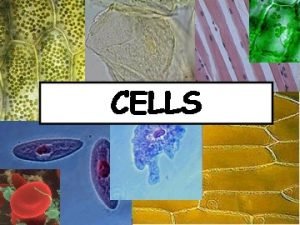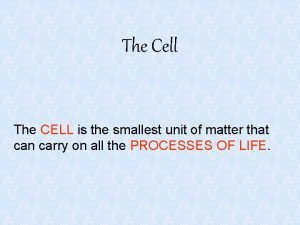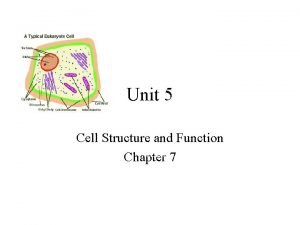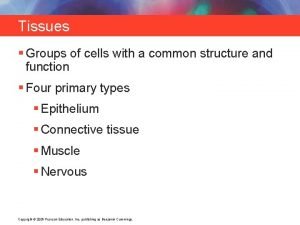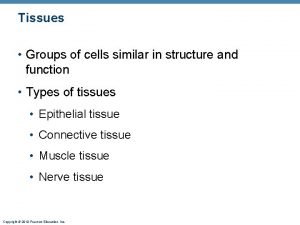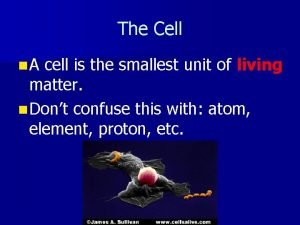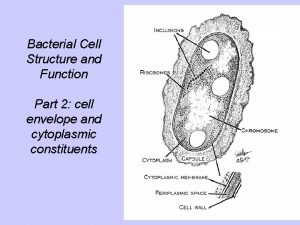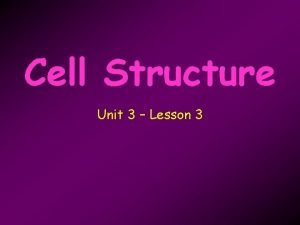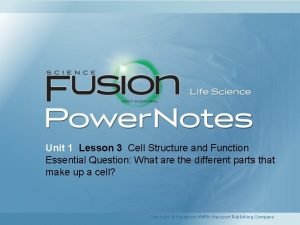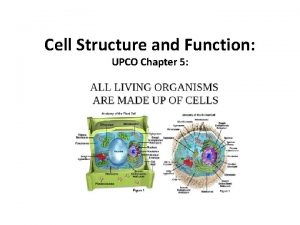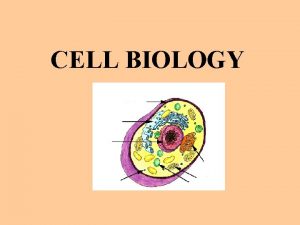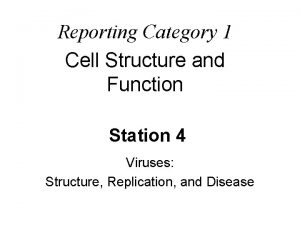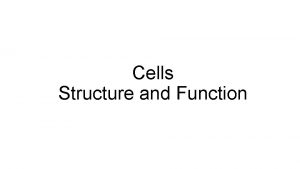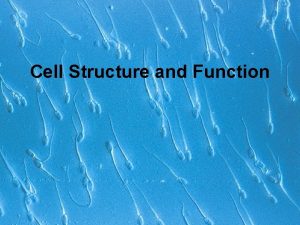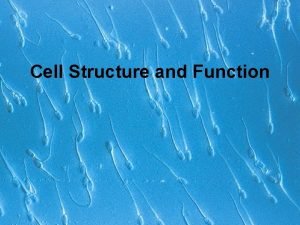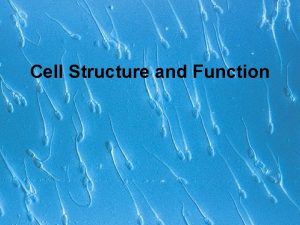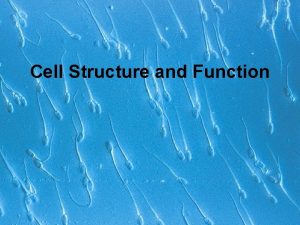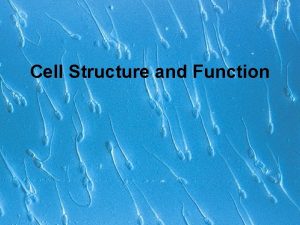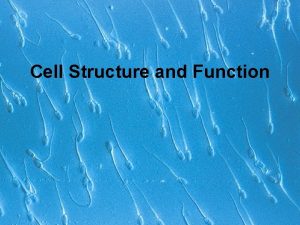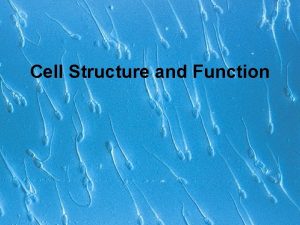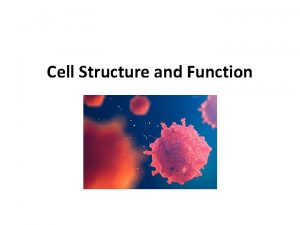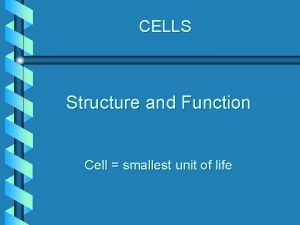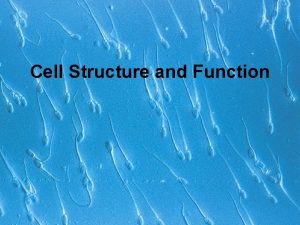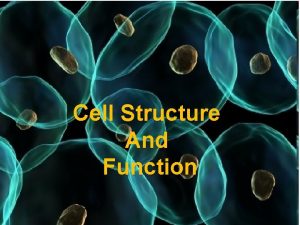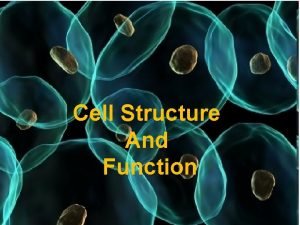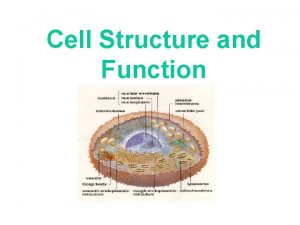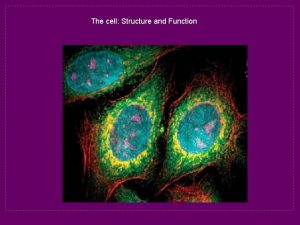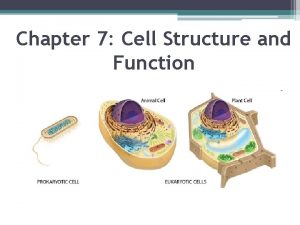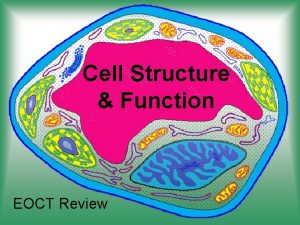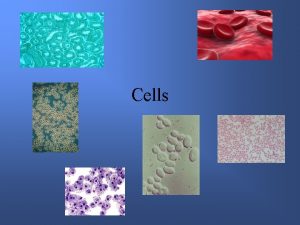CELLS Structure and Function Cell smallest unit of





































- Slides: 37

CELLS Structure and Function Cell = smallest unit of life

Cell Theory • 1. Cells are the smallest unit of life. • 2. All living things are made of cells. • 3. All cells arise from other cells.

Turn to your neighbor…… • Which of these 3 parts can you relate to the characteristics of life?

Two Major Cell Types Cell Type Prokaryotic Eukaryotic Example Bacteria Protists Fungi Plants Animals

Prokaryotic Cell

Features of Prokaryotic Cells All prokaryotic cells contain Structure Plasma Membrane Nucleoid Cytoplasm Function Regulates flow of substances into and out of cell Cytoplasmic region containing genetic material Cytosol: fluid Ribosomes Enzymes

Features of Prokaryotic Cells Other possible prokaryotic structures Structure Cell Wall Capsule Infolded Plasma Membranes Function Supports cell Maintains shape Protects from drying Protects against white blood cells Metabolism Cell division

Features of Prokaryotic Cells Other possible prokaryotic structures Structure Bacterial Flagellum Plasmid Function Movement Small circular DNA Replicates independently

Kingdoms that are Prokaryotic • Archaea • Eubacteria



Endosymbiosis • Endosymbiotic Theory: – Mitochondria and chloroplasts were thought to have been free- living prokaryotic cells – These structures were taken in by a eukaryotic cell, became useful to the cell metabolism and were retained as organelles • Evidence: – Both mitochondria and chloroplasts have: • • • 70 s ribosomes Own DNA Ability to reproduce independently from the cell • Double membrane on outside • Same size as prokaryotic cells

Functions of Eukaryotic Cell Features Structure Function Chloroplast Photosynthesis: Uses light (protists, plants) energy to produce organic molecules

Functions of Eukaryotic Cell Features Structure Mitochondrion Function Captures energy from organic molecules, producing ATP

Turn to your neighbor…… • Compare the mitochondria to the chloroplast.


Eukaryotic Cell (protist, animal)

Discuss the differences between prokaryotic and eukaryotic cells.

Eukaryotic Cell (plant)

Compare the animal cell to the plant cell.

Functions of Eukaryotic Cell Features Structure Function(s) 1. Regulates passage of Plasma materials into and out of cell Membrane 2. Cell-Cell Recognition

Functions of Eukaryotic Cell Features Structure Cell Wall (protists, fungi, plants) Function(s) 1. Controls cell shape, protects, supports

Turn to your neighbor: • Compare the structure of the cell membrane to the structure of the cell wall.

Functions of Eukaryotic Cell Features Structure Nucleus Function(s) 1. Carrier of genetic material DNA + protein = chromatin 2. Governs cell activities 3. Directs cell reproduction 4. Surrounded by Membrane = nuclear envelope 5. Contains nucleolus— produces ribosomes which synthesize proteins

Functions of Eukaryotic Cell Features Structure SER RER Function(s) Rough 1. Associated ribosomes produce Endoplasmic proteins Reticulum (RER) 2. Prepares proteins for export Smooth 1. Lipid Synthesis Endoplasmic 2. Drug detoxification Reticulum (SER) 3. Transport of proteins from RER

Functions of Eukaryotic Cell Features Structure Function(s) Golgi Apparatus Collects, modifies, packages and distributes proteins and lipids from ER

Turn to your neighbor…… • Compare the function of the E. R. with the function of the Golgi.

Functions of Eukaryotic Cell Features Structure Lysosome Function(s) Contains digestive enzymes to digest food in protists or destroy aging organelles

Functions of Eukaryotic Cell Features Structure Function Centriole Gives rise to basal bodies that produce cilia or flagella

Functions of Eukaryotic Cell Features Structure Function(s) Vacuole 1. Central vacuole (plants) stores waste, maintains turgidity. 2. Contractile vacuole (protists) maintains water balance. 3. Food vacuole (protists) fuses with lysosome for digestion.

Functions of Eukaryotic Cell Features Structure Cilia and Flagella Function(s) 1. Move substances across cell surface in lungs, fallopian tubes 2. Cell movement in sperm, protists

Exit Ticket 1. What are similarities for a. eukaryotic and prokaryotic cells? b. animal and plant cells? 2. What are differences between a. eukaryotic and prokaryotic cells? b. animal and plant cells?


Kingdoms that are Eukaryotic • Protists: • Eukaryotic • Some have cell walls, but some don’t • Contain uni- and multicellular organisms • Some are autotrophic and some are heterotrophic • Only characteristic they have in common is they are all eukaryotic

Eukaryotic Kingdoms, cont. • Fungi Contains mushrooms, yeast, mold and mildew Eukaryotic Have cell walls made of chitin Yeast are unicellular; all others are multicellular Heterotrophic – absorptive

Eukaryotic Kingdoms, cont. • Plantae: Includes all the plants Eukaryotic Have cell walls made of cellulose Multicellular Autotrophic Contain chloroplasts

Eukaryotic Kingdoms, cont. • Animalia: Eukaryotic No cell walls Multicellular Heterotrophic Only Kingdom with NO cell walls
 The smallest unit of life is the
The smallest unit of life is the Cells are the smallest unit of life
Cells are the smallest unit of life A cell is the smallest unit of life
A cell is the smallest unit of life Unit 5 cell structure and function answer key
Unit 5 cell structure and function answer key Muscle tissue parts
Muscle tissue parts Group of cells that are similar in structure and function
Group of cells that are similar in structure and function A group of cells similar in structure and function
A group of cells similar in structure and function Smallest cells
Smallest cells Onodi cells and haller cells
Onodi cells and haller cells Chlorocruorin
Chlorocruorin Animal cell plant cell venn diagram
Animal cell plant cell venn diagram Masses of cells form and steal nutrients from healthy cells
Masses of cells form and steal nutrients from healthy cells Function of cells
Function of cells Bacterial cell structure and function
Bacterial cell structure and function Lesson 3 cell structure and function answer key
Lesson 3 cell structure and function answer key Organelles graphic organizer
Organelles graphic organizer K+ pump
K+ pump Cell
Cell Biology chapter 7 cell structure and function
Biology chapter 7 cell structure and function Chapter 7 cell structure and function section review 7-2
Chapter 7 cell structure and function section review 7-2 Organelle graphic organizer answer key
Organelle graphic organizer answer key Chapter 5 cell structure and function
Chapter 5 cell structure and function Plastids in plant cell
Plastids in plant cell Category 1 cell structure and function
Category 1 cell structure and function Category 1 cell structure and function
Category 1 cell structure and function Category 1 cell structure and function
Category 1 cell structure and function Tubular lumen
Tubular lumen Parafollicular cells vs follicular cells
Parafollicular cells vs follicular cells Gamete vs somatic cell
Gamete vs somatic cell Somatic vs germ cells
Somatic vs germ cells What is eukarya
What is eukarya Prokaryotic cells
Prokaryotic cells Why did robert hooke name cells “cells”?
Why did robert hooke name cells “cells”? Pseudostratified vs simple columnar
Pseudostratified vs simple columnar What cell type
What cell type Is a red blood cell prokaryotic or eukaryotic
Is a red blood cell prokaryotic or eukaryotic Chapter 8 cellular reproduction cells from cells
Chapter 8 cellular reproduction cells from cells Cell substance
Cell substance
